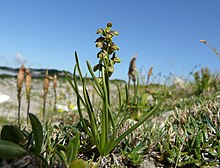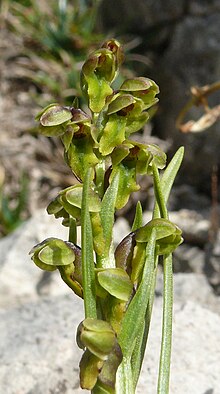Dwarf stendel
| Dwarf stendel | ||||||||||||
|---|---|---|---|---|---|---|---|---|---|---|---|---|

Dwarf stendel ( Chamorchis alpina ) |
||||||||||||
| Systematics | ||||||||||||
|
||||||||||||
| Scientific name of the genus | ||||||||||||
| Chamorchis | ||||||||||||
| Rich. | ||||||||||||
| Scientific name of the species | ||||||||||||
| Chamorchis alpina | ||||||||||||
| ( L. ) Rich. |
The dwarf stendel ( Chamorchis alpina ), also called dwarf orchid or dwarf gorchis , is the only species of the monotypical genus Chamorchis within the orchid family (Orchidaceae). It is inconspicuous and thrives in the high alpine altitude . Because of their small size and inconspicuous flowers, it is not easy to find them.
Description and ecology
Vegetative characteristics
The dwarf stendel is a graceful perennial herbaceous plant . It forms small, oblong-oval tubers as persistence organs. Due to the ability to form more than one new tuber per year ( vegetative reproduction ), the plants are usually in small groups.
The grass-like leaves are usually shorter than 5 centimeters.
Generative characteristics
The inflorescence contains up to twelve flowers. The hermaphrodite flowers are zygomorphic . The inflorescence is yellow-green and mostly reddish brown. The bracts of the outer circle of perigone and the two sides of the inner circle are inclined to form a helmet. The spurless lip is 3 to 5 millimeters long and usually only vaguely three-lobed. Its flowers are not fragrant, but have plenty of nectar . As pollinators were parasitic wasps , flies and beetles observed.
The flowering period extends from July to August. While the seeds are ripe, the flowers are usually not completely faded. The lip has dried up, but the helmet is still intact. The flowers are pollinated, but if this does not happen, the flowers are autogamous , since mostly all capsule fruits ripen.
Genetics and development
The dwarf stendel has a karyotype of two sets of chromosomes and 21 chromosomes each ( cytology : 2n = 42). The seed of this orchid does not contain any nutrient tissue for the seedling . The germination therefore takes place only when infection by a root fungus ( mycorrhiza ).
Occurrence
distribution
The distribution area extends over those parts of the Alps and the Carpathians , which have high mountain character, as well as over the west Scandinavian mountains. The entire distribution area includes subarctic and subalpine Europe. The dwarf stendel is (according to Buttler ) an Alpine, Scandinavian, Carpathian, Lapponian floral element .
Site conditions

The dwarf stendel is a lime-loving plant and prefers extreme locations above the tree line with little snow cover and frequent wind. Solar radiation is also high at these locations. The edelweiss and white silver arum often grow near it. It rarely grows together with cabbage florets, which largely avoid the extreme locations.
It can be found in the plant society Polsterseggenrasen ( Association Caricetum firmae ) from the Seslerion association.
Locations and distribution in Central Europe
The dwarf stendel thrives best on lime-rich, loose and therefore often stony, humus-rich and somewhat damp rather than dry, cool soils .
It grows almost exclusively over limestone or dolomite , more rarely over calcareous slates (e.g. Bündner slate ). In Central Europe it occurs exclusively in the Alps, where it settles primarily at altitudes of 1500 to 2800 meters. In the Allgäu Alps, it rises on the saddle between Biberkopf and Hochrappenkopf in Bavaria to an altitude of 2320 meters.
The inconspicuous dwarf stendel is extremely cold-resistant and can withstand drafts. It is therefore particularly found in places exposed to wind (e.g. on ridges , on rocky outcrops or in strips of grass in steep walls).
Conservation and endangerment
Like all orchid species found in Europe, the dwarf stendel is also subject to strict protection by European and national laws.
Due to its inconspicuous appearance and small size, the dwarf stendel is rarely picked. In the vicinity of mountain peaks, step damage by hikers is possible. The populations are currently still largely stable and not endangered despite the small distribution area. Many locations are probably unknown because they are in inaccessible regions.
In its Scandinavian distribution area, the dwarf stendel is classified as low risk. The causes of endangerment are succession and overgrazing through reindeer herding .
Systematics
It was first published in 1753 under the name ( Basionym ) Ophrys alpina by Carl von Linné . At that time orchids with spurless flowers were placed in the genus Ragwurzen ( Ophrys ). The new combination to Chamorchis alpina was published in 1817 by Louis Claude Marie Richard , with whom he established the genus Chamorchis .
The relationship to the other representatives of the subtribe Orchidinae was not clarified for a long time. The investigations of the genetic traits by Bateman 1997 showed that the closest relative of this species is the spherical orchid ( Traunsteinera globosa ).
Image gallery
Individual evidence
- ↑ Rafaël Govaerts (ed.): Chamorchis. In: World Checklist of Selected Plant Families (WCSP) - The Board of Trustees of the Royal Botanic Gardens, Kew . Retrieved November 27, 2016.
- ^ Erich Oberdorfer : Plant-sociological excursion flora for Germany and neighboring areas . With the collaboration of Angelika Schwabe and Theo Müller. 8th, heavily revised and expanded edition. Eugen Ulmer, Stuttgart (Hohenheim) 2001, ISBN 3-8001-3131-5 , pp. 277 .
- ↑ Erhard Dörr, Wolfgang Lippert : Flora of the Allgäu and its surroundings. Volume 1, IHW, Eching 2001, ISBN 3-930167-50-6 , p. 390.
- ^ T. Perschke: Status of endangered orchids of the Baltic-Fennoscandic area . In: Journal Europäische Orchideen , Volume 38, No. 4, 2006, pp. 717-798, ISSN 0945-7909
literature
Standard literature on orchids
- Karl-Peter Buttler : Orchids, the wild growing species of Europe. Mosaik Verlag 1986, ISBN 3-570-04403-3 .
- H. Baumann , S. Künkele : The wild growing orchids of Europe. Franckh, 1982, ISBN 3-440-05068-8 .
- Robert L. Dressler: The orchids - biology and systematics of the Orchidaceae. 1996.
- Hans Sundermann : European and Mediterranean orchids. Brücke-Verlag, 2nd edition: 1975, ISBN 3-87105-010-5 .
- JG Williams: Orchids of Europe with North Africa and Asia Minor. BLV Verlag, ISBN 3-405-11901-4 .
- Dietmar Aichele, Heinz-Werner Schwegler: The flowering plants of Central Europe. Volume 5 swan flowers to duckweed plants. Franckh-Kosmos-Verlag, 2nd revised edition, Stuttgart 2000, ISBN 3-440-08048-X .
Special literature
- RM Bateman, PM Hollingsworth, J. Preston, Y.-B. Luo, AM Pridgeon, MW Chase: Molecular phylogenetics and evolution of Orchidinae and selected habenariinae (Orchidaceae). In: Bot. J. Linn. Soc. , Volume 142, 2003, pp. 1-40.
Web links
- Chamorchis alpina (L.) Rich., Dwarf Gorchis. In: FloraWeb.de.
- Dwarf stendel . In: BiolFlor, the database of biological-ecological characteristics of the flora of Germany.
- Profile and distribution map for Bavaria . In: Botanical Information Hub of Bavaria .
- Thomas Meyer: Data sheet with identification key and photos at Flora-de: Flora von Deutschland (old name of the website: Flowers in Swabia ).
- Chamorchis alpina inthe IUCN 2013 Red List of Endangered Species . Posted by: H. Rankou, 2011. Retrieved September 2, 2013.
- Distribution maps:




